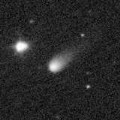
|
Now it is 13.0 mag (Nov. 5, Seiichi Yoshida). It is expected to brighten up to 7 mag in 2017 summer. In the Northern Hemisphere, it keeps observable in good condition until the highlight while the comet will be brightening. In the Southern Hemisphere, it is not observable until early 2017.
Date(TT) R.A. (2000) Decl. Delta r Elong. m1 Best Time(A, h)
Nov. 12 12 43.99 45 35.9 3.284 3.112 71 12.2 5:04 (237, 42)
Nov. 19 12 59.26 45 13.8 3.165 3.046 74 12.0 5:10 (238, 45)
|
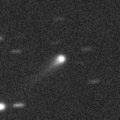
|
It brightened very rapidly and became brighter than expected. Now it is very bright as 12.5 mag (Nov. 1, Chris Wyatt). It will be unobservable in November in the Southern Hemisphere, or in December in the Northern Hemisphere.
Date(TT) R.A. (2000) Decl. Delta r Elong. m1 Best Time(A, h)
Nov. 12 17 42.19 -17 1.3 2.709 2.001 36 12.8 18:23 ( 59, 12)
Nov. 19 17 59.56 -16 46.4 2.755 2.009 33 12.9 18:20 ( 61, 11)
|
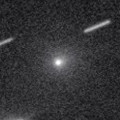
|
Now it is bright as 12.2 mag (Nov. 4, Seiichi Yoshida). It keeps locating extremely low until November in the Southern Hemisphere.
Date(TT) R.A. (2000) Decl. Delta r Elong. m1 Best Time(A, h)
Nov. 12 11 48.78 -2 20.2 2.069 1.647 51 13.0 5:04 (298, 30)
Nov. 19 12 4.05 -4 6.6 2.057 1.685 54 13.2 5:10 (303, 32)
|
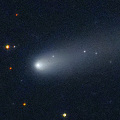
|
Now it is 12.7 mag (Nov. 4, Seiichi Yoshida). It will be getting higher gradually after this, but it will be fading.
Date(TT) R.A. (2000) Decl. Delta r Elong. m1 Best Time(A, h)
Nov. 12 11 6.06 -8 12.5 1.904 1.646 59 13.5 5:04 (312, 33)
Nov. 19 11 19.22 -10 24.6 1.891 1.688 62 13.7 5:10 (318, 34)
|
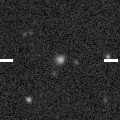
|
It is appearing in the morning sky in the Northern Hemisphere. It is expected to brighten up to 7 mag in 2017 spring. But it locates somewhat low at the high light. It was 16.4 mag in August (Aug. 12, Thomas Lehmann), the brightness evolution seemed to have slowed down. It will be observable in the morning sky in December also in the Southern Hemisphere.
Date(TT) R.A. (2000) Decl. Delta r Elong. m1 Best Time(A, h)
Nov. 12 13 34.03 -12 56.6 3.692 2.812 23 13.8 5:04 (289, 4)
Nov. 19 13 45.23 -13 55.2 3.569 2.732 27 13.6 5:10 (293, 7)
|

|
Outburst occured on Oct. 21, and it brightened up to 13.8 mag (Jean-Francois Soulier). It is bright as 12.3 mag still now (Nov. 4, Seiichi Yoshida).
Date(TT) R.A. (2000) Decl. Delta r Elong. m1 Best Time(A, h)
Nov. 12 19 33.29 -23 40.1 6.297 5.889 61 13.8 18:23 ( 34, 23)
Nov. 19 19 37.64 -23 24.2 6.391 5.887 55 13.8 18:20 ( 38, 21)
|

|
It brightened up to 8-9 mag from last winter to spring. Now it is fading. It has already faded down to 12.9 mag (July 23, Chris Wyatt). It is appearing in the morning sky in the Northern Hemisphere. It will be observable in the morning sky in December also in the Southern Hemisphere.
Date(TT) R.A. (2000) Decl. Delta r Elong. m1 Best Time(A, h)
Nov. 12 12 57.55 -4 49.1 4.994 4.218 34 13.8 5:04 (288, 16)
Nov. 19 13 1.40 -5 51.1 4.980 4.276 40 13.9 5:10 (293, 21)
|
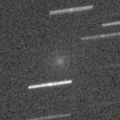
|
It approached to the Sun down to 0.45 a.u. on Oct. 10. It was 12.5-13.0 mag on Sept. 24 (Michael Jager). Michael Mattiazzo reported that it was not detected, fainter than 10 mag, on the STEREO spacecraft images from Oct. 24 to 30. It will never be observable again in the Northern Hemisphere. In the Southern Hemisphere, it is appearing in the evening sky, but it keeps extremely low after this. It has a very similar orbit to Comet C/1915 R1 ( Mellish ).
Date(TT) R.A. (2000) Decl. Delta r Elong. m1 Best Time(A, h)
Nov. 12 16 28.13 -32 39.7 1.699 0.881 23 14.1 18:23 ( 57,-11)
Nov. 19 17 0.45 -37 17.7 1.808 1.007 25 14.8 18:20 ( 53,-12)
|

|
It brightened up to 11 mag from spring to summer. Now it is not observable. It will be observable at 16 mag again in 2017 spring.
Date(TT) R.A. (2000) Decl. Delta r Elong. m1 Best Time(A, h)
Nov. 12 15 35.26 -17 7.5 2.920 1.939 6 14.1 18:23 ( 78,-13)
Nov. 19 15 52.71 -18 5.4 2.961 1.976 3 14.3 18:20 ( 78,-14)
|
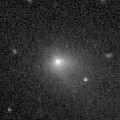
|
Now it is bright as 13.6 mag (Oct. 31, Chris Wyatt). Distant object, but it keeps observable at 13-14 mag for a long time from 2015 to 2016.
Date(TT) R.A. (2000) Decl. Delta r Elong. m1 Best Time(A, h)
Nov. 12 0 33.69 -5 3.6 4.282 5.035 135 14.2 21:06 ( 0, 50)
Nov. 19 0 33.36 -5 14.7 4.375 5.047 128 14.2 20:38 ( 0, 50)
|
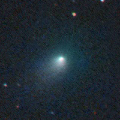
|
Now it is 14.4 mag (Oct. 22, Thomas Lehmann). It will be fading gradually after this. In the Northern Hemisphere, it keeps low after this. In the Southern Hemisphere, it will be getting lower after this, and it will be unobservable in December.
Date(TT) R.A. (2000) Decl. Delta r Elong. m1 Best Time(A, h)
Nov. 12 18 44.58 -29 58.6 2.290 1.823 50 14.3 18:23 ( 40, 12)
Nov. 19 19 5.57 -29 40.1 2.370 1.857 47 14.6 18:20 ( 40, 12)
|

|
It keeps unobservable for a long time. It will appear in the morning sky in December, when the comet will be fainter than 15 mag.
Date(TT) R.A. (2000) Decl. Delta r Elong. m1 Best Time(A, h)
Nov. 12 13 49.36 -14 35.7 2.681 1.779 19 14.6 5:04 (288, 0)
Nov. 19 14 7.22 -15 47.0 2.717 1.838 21 14.8 5:10 (291, 2)
|
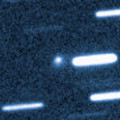
|
Now it is 15.4 mag (Oct. 9, Kunihiro Shima). It will brighten up to 14 mag from winter to spring in 2017, and it will be observable in excellent condition in the Northern Hemisphere. In the Southern Hemisphere, it keeps extremely low until November, and it will be low also around the higlight.
Date(TT) R.A. (2000) Decl. Delta r Elong. m1 Best Time(A, h)
Nov. 12 10 39.50 25 2.9 2.426 2.428 78 14.8 5:04 (281, 60)
Nov. 19 10 51.56 24 50.8 2.345 2.425 82 14.7 5:10 (286, 64)
|

|
It will approach to the earth down to 0.08 a.u. to the earth in mid February, and it is expected to be observable at 6 mag in good condition. Now it is 16.4 mag (Nov. 6, A. Chapman). It will brighten rapidly after this, but it keeps very low in the evening sky for a while. It will be unobservable temporarily in January. Then it keeps observable in good condition after mid February.
Date(TT) R.A. (2000) Decl. Delta r Elong. m1 Best Time(A, h)
Nov. 12 18 28.22 -25 37.0 1.488 1.082 46 15.9 18:23 ( 45, 13)
Nov. 19 18 46.20 -25 26.3 1.422 0.982 43 14.8 18:20 ( 47, 12)
|
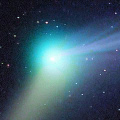
|
It brightened up to 6 mag from last autumn to last winter. Now it is fading. It has already faded down to 15.2 mag (Nov. 2, Yuji Ohshima). It is observable in good condition in the Northern Hemisphere. It is not observable after this in the Southern Hemisphere.
Date(TT) R.A. (2000) Decl. Delta r Elong. m1 Best Time(A, h)
Nov. 12 4 39.78 57 12.1 4.131 4.902 137 15.0 1:16 (180, 68)
Nov. 19 4 24.62 57 0.2 4.160 4.972 141 15.1 0:34 (180, 68)
|

|
It has been lost since its discovery in 1978. In 2016, it is expected to return in excellent condition from autumn to winter.
Date(TT) R.A. (2000) Decl. Delta r Elong. m1 Best Time(A, h)
Nov. 12 21 55.89 -19 43.8 0.749 1.287 94 15.1 18:30 ( 0, 36)
Nov. 19 22 19.37 -16 51.1 0.768 1.290 93 15.2 18:26 ( 0, 38)
|

|
Now it is 14.6 mag (Oct. 15, Ken-ichi Kadota). It will be fading gradually after this. It will be unobservable soon. But it will appear in the morning sky again at 16 mag in late December in the Northern Hemisphere, or in late January in the Southern Hemisphere.
Date(TT) R.A. (2000) Decl. Delta r Elong. m1 Best Time(A, h)
Nov. 12 16 16.87 4 25.4 4.513 3.666 27 15.2 18:23 ( 90, 8)
Nov. 19 16 22.93 3 10.0 4.583 3.712 25 15.3 18:20 ( 91, 3)
|
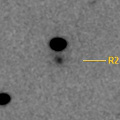
|
Now it is very bright as 15.6 mag (Oct. 25, L. Elenin). It will be observable at 11 mag for a long time from 2017 to 2018. Now it is observable in excellent condition in the Southern Hemisphere. But it keeps low for a while in the Northern Hemisphere.
Date(TT) R.A. (2000) Decl. Delta r Elong. m1 Best Time(A, h)
Nov. 12 3 22.77 -41 35.0 5.260 5.827 120 15.3 23:54 ( 0, 13)
Nov. 19 3 17.33 -41 21.9 5.231 5.775 118 15.2 23:21 ( 0, 14)
|
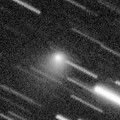
|
It brightened up to 11.6 mag from late August to early September (Aug. 29, Juan Jose Gonzalez). Now it is fading rapidly. It has already faded down to 15.6 mag (Oct. 22, E. Bryssinck). It will be low in November.
Date(TT) R.A. (2000) Decl. Delta r Elong. m1 Best Time(A, h)
Nov. 12 18 44.64 -17 23.2 2.553 2.079 51 15.2 18:23 ( 48, 22)
Nov. 19 18 46.05 -18 48.6 2.709 2.116 44 15.5 18:20 ( 51, 17)
|
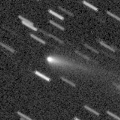
|
Now it is 15.5 mag (Oct. 31, Sandor Szabo). It will be observable at 15-16 mag in good condition from autumn to winter. It locates somewhat low in the Southern Hemisphere.
Date(TT) R.A. (2000) Decl. Delta r Elong. m1 Best Time(A, h)
Nov. 12 4 36.49 34 28.4 1.736 2.662 154 15.5 1:12 ( 0, 90)
Nov. 19 4 31.43 34 32.6 1.727 2.680 160 15.5 0:40 ( 0, 90)
|
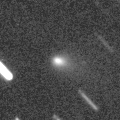
|
It had been lost for a long time over 200 years since its discovery in 1783. It brightened rapidly, and reached up to 13.9 mag in September (Spet. 1, Sandor Szabo). Now it is 14.5 mag (Nov. 4, Seiichi Yoshida). It will be fading after this. It is observable in excellent condition for a while in the Northern Hemisphere. It will be unobservable soon in the Southern Hemisphere.
Date(TT) R.A. (2000) Decl. Delta r Elong. m1 Best Time(A, h)
Nov. 12 5 10.97 42 35.3 0.991 1.885 144 15.6 1:47 (180, 83)
Nov. 19 4 56.26 46 52.6 0.994 1.907 148 15.8 1:05 (180, 78)
|
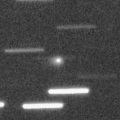
|
Now it is 15.7 mag (Oct. 31, Sandor Szabo). It will brighten up to 12-13 mag and will be observable in good condition in 2017 summer. In 2016, it keeps observable until winter when it will brighten up to 15.5 mag. It locates somewhat low in the Southern Hemisphere.
Date(TT) R.A. (2000) Decl. Delta r Elong. m1 Best Time(A, h)
Nov. 12 1 29.01 26 49.2 3.062 3.982 155 15.6 22:00 ( 0, 82)
Nov. 19 1 14.95 25 23.9 3.072 3.934 146 15.6 21:19 ( 0, 80)
|
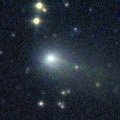
|
It brightened up to 12.5 mag in summer (Aug. 3, Marco Goiato). Now it is fading. It has already faded down to 15.0 mag (Oct. 31, Sandor Szabo). It keeps observable in good condition for a while.
Date(TT) R.A. (2000) Decl. Delta r Elong. m1 Best Time(A, h)
Nov. 12 21 28.99 -16 13.5 2.717 2.886 89 15.7 18:23 ( 6, 39)
Nov. 19 21 36.72 -15 44.9 2.839 2.914 84 15.8 18:20 ( 12, 39)
|
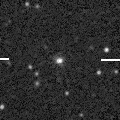
|
Now it is 16.3 mag (Nov. 5, Y. Sugiyama). It will brighten up to 15 mag in winter. But it will be getting lower gradually after autumn.
Date(TT) R.A. (2000) Decl. Delta r Elong. m1 Best Time(A, h)
Nov. 12 22 3.15 -6 15.9 1.591 2.025 100 15.8 18:36 ( 0, 49)
Nov. 19 22 9.33 -5 12.3 1.633 1.989 95 15.7 18:20 ( 2, 50)
|
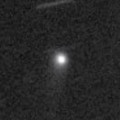
|
Now it is 15.8 mag (Oct. 31, Sandor Szabo). It will brighten up to 14 mag from summer to winter in 2017. Then it will be observable in excellent condition in the Northern Hemisphere. In the Southern Hemisphere, it is hardly observable around the highlight.
Date(TT) R.A. (2000) Decl. Delta r Elong. m1 Best Time(A, h)
Nov. 12 22 54.45 -12 41.6 3.863 4.306 110 15.8 19:27 ( 0, 42)
Nov. 19 22 51.55 -11 45.9 3.934 4.264 102 15.8 18:56 ( 0, 43)
|

|
Now it is 18.1 mag (Oct. 10, Jean-Francois Soulier). It will brighten up to 12 mag from winter to spring. In the Northern Hemisphere, it keeps observable while the comet is brightening gradually. But it will be unobservable in late February. In the Southern Hemisphere, it keeps unobservable until December. But it keeps observable for a long time after late December.
Date(TT) R.A. (2000) Decl. Delta r Elong. m1 Best Time(A, h)
Nov. 12 12 47.73 3 51.9 2.496 1.866 41 16.2 5:04 (282, 23)
Nov. 19 13 4.27 2 8.0 2.386 1.803 43 15.8 5:10 (286, 25)
|
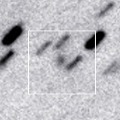
|
Now it is 15.8 mag (Oct. 22, Ken-ichi Kadota). It keeps 16-17 mag for a long time from 2016 to 2019. It keeps locating near by the equator.
Date(TT) R.A. (2000) Decl. Delta r Elong. m1 Best Time(A, h)
Nov. 12 9 20.90 1 47.8 9.691 9.704 87 16.2 5:04 (337, 55)
Nov. 19 9 21.89 1 41.7 9.571 9.697 94 16.1 5:10 (351, 56)
|
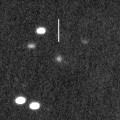
|
Now it is 16.8 mag (Oct. 7, D. Buczynski). It will be observable at 16-17 mag in good condition from autumn to winter. It locates low in the Southern Hemisphere.
Date(TT) R.A. (2000) Decl. Delta r Elong. m1 Best Time(A, h)
Nov. 12 7 32.57 24 34.0 3.256 3.833 118 16.2 4:08 ( 0, 80)
Nov. 19 7 32.47 24 46.5 3.161 3.825 125 16.2 3:40 ( 0, 80)
|
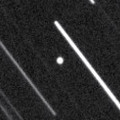
|
It brightened up to 14.9 mag in September (Sept. 29, Sandor Szabo). In the Northern Hemisphere, it keeps observable in excellent condition, but it will be fading after this. It keeps locating very low in the Southern Hemisphere.
Date(TT) R.A. (2000) Decl. Delta r Elong. m1 Best Time(A, h)
Nov. 12 22 47.28 32 47.3 0.855 1.597 119 16.3 19:20 ( 0, 88)
Nov. 19 22 56.34 29 0.5 0.978 1.667 115 16.7 19:02 ( 0, 84)
|
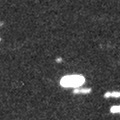
|
Now it is 16.5 mag (Nov. 4, D. Buczynski). It will brighten up to 15 mag and will be observable in good condition from autum to winter in 2017. In the Northern Hemisphere, it keeps observable in good condition for a long time while the comet will be brightening. It is not observable until 2017 summer in the Southern Hemisphere.
Date(TT) R.A. (2000) Decl. Delta r Elong. m1 Best Time(A, h)
Nov. 12 3 37.34 59 2.4 4.594 5.374 138 16.6 0:14 (180, 66)
Nov. 19 3 21.36 58 15.2 4.535 5.340 141 16.6 23:25 (180, 67)
|
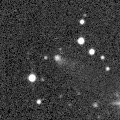
|
It brightened rapidly. Now it is 16.7 mag (Oct. 15, Ken-ichi Kadota). It is observable at 16.5 mag in good condition from autumn to winter.
Date(TT) R.A. (2000) Decl. Delta r Elong. m1 Best Time(A, h)
Nov. 12 22 38.24 -8 41.2 2.171 2.650 108 16.6 19:11 ( 0, 46)
Nov. 19 22 42.01 -7 52.4 2.247 2.639 102 16.7 18:47 ( 0, 47)
|
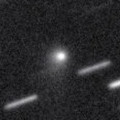
|
It brightened up to 15 mag in early 2016. Now it is fading. It has already faded down to 16.9 mag (Nov. 4, D. Buczynski). In the Northern Hemisphere, it keeps observable in good condition for a long time until 2017 autumn when the comet will be fainter than 18 mag. It will never be observable after this in the Southern Hemisphere.
Date(TT) R.A. (2000) Decl. Delta r Elong. m1 Best Time(A, h)
Nov. 12 13 59.17 66 11.3 5.995 5.989 84 16.7 5:04 (209, 35)
Nov. 19 14 11.29 65 59.1 5.984 6.014 87 16.7 5:10 (210, 37)
|

|
Now it is 17.3 mag (Nov. 7, Mt. Lemmon Survey). It will be getting higher after this, and it will be observable at 17 mag in good condition in winter.
Date(TT) R.A. (2000) Decl. Delta r Elong. m1 Best Time(A, h)
Nov. 12 11 30.77 3 0.4 2.659 2.288 57 16.8 5:04 (297, 37)
Nov. 19 11 41.70 2 8.4 2.609 2.314 61 16.8 5:10 (303, 41)
|
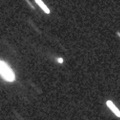
|
Now it is 16.7 mag (Oct. 3, A. Diepvens). It brightened rapidly, and became brighter than originally expected. It keeps 17 mag until 2017. In the Northern Hemisphere, it keeps observable in excellent condition for a long time. It is not observable in the Southern Hemisphere.
Date(TT) R.A. (2000) Decl. Delta r Elong. m1 Best Time(A, h)
Nov. 12 13 37.63 54 19.2 7.501 7.301 74 16.9 5:04 (224, 35)
Nov. 19 13 40.18 54 18.6 7.447 7.305 77 16.9 5:10 (225, 39)
|
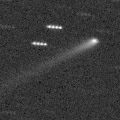
|
It brightened up to 15 mag from late 2014 to early 2016. Now it is fading slowly. Now it is 17.1 mag (Nov. 5, Y. Sugiyama). In the Northern Hemisphere, it will be observable at 16-17 mag in autumn in good condition. It locates extremely low in the Southern Hemisphere.
Date(TT) R.A. (2000) Decl. Delta r Elong. m1 Best Time(A, h)
Nov. 12 21 22.50 35 51.8 5.180 5.485 102 17.2 18:23 (101, 84)
Nov. 19 21 20.16 34 57.4 5.304 5.520 97 17.2 18:20 ( 94, 79)
|
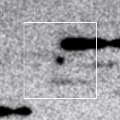
|
Now it is 16.7 mag (Nov. 3, iTelescope Observatory, Siding Spring). It keeps 16 mag for a long time from 2017 to 2018.
Date(TT) R.A. (2000) Decl. Delta r Elong. m1 Best Time(A, h)
Nov. 12 9 49.96 -12 19.8 6.157 6.008 76 17.2 5:04 (334, 39)
Nov. 19 9 49.45 -12 15.0 6.018 5.985 83 17.2 5:10 (345, 41)
|
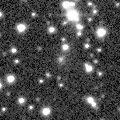
|
It will pass the perihelion in 2019. However, it has not been brightening since the discovery in 2010. Now it is 17.3 mag (Nov. 4, D. Buczynski). It keeps observable in excellent condition in the Northern Hemisphere. It is not observable in the Southern Hemisphere.
Date(TT) R.A. (2000) Decl. Delta r Elong. m1 Best Time(A, h)
Nov. 12 4 26.23 61 18.4 9.041 9.758 134 17.2 1:03 (180, 64)
Nov. 19 4 21.56 61 36.4 8.990 9.738 137 17.2 0:30 (180, 63)
|
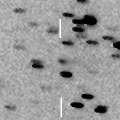
|
Now it is 17.1 mag (Nov. 6, CAO, San Pedro de Atacama). In the Northern Hemisphere, it will be observable at 17 mag in excellent condition in winter. It locates low in the Southern Hemisphere.
Date(TT) R.A. (2000) Decl. Delta r Elong. m1 Best Time(A, h)
Nov. 12 7 19.86 33 3.1 2.754 3.387 122 17.3 3:55 ( 0, 88)
Nov. 19 7 20.58 33 21.7 2.679 3.389 128 17.2 3:28 ( 0, 88)
|
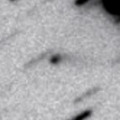
|
Now it is 17.9 mag (Nov. 2, Purple Mountain Observatory, XuYi Station). It was observed at 17 mag last winter. It will be observable at 17 mag again next winter. It is observable in good condition in the Northern Hemisphere. But it locates low in the Southern Hemisphere.
Date(TT) R.A. (2000) Decl. Delta r Elong. m1 Best Time(A, h)
Nov. 12 10 52.93 14 39.8 4.007 3.802 71 17.3 5:04 (293, 52)
Nov. 19 10 59.12 15 23.4 3.917 3.818 76 17.3 5:10 (300, 57)
|
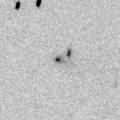
|
Now it is 17.2 mag (Oct. 21, Mt. Lemmon Survey). It tends to be brightest after the perihelion passage. It is observable at 17.5 mag in good condition from autumn to winter.
Date(TT) R.A. (2000) Decl. Delta r Elong. m1 Best Time(A, h)
Nov. 12 2 16.12 -0 31.0 2.167 3.105 157 17.4 22:48 ( 0, 55)
Nov. 19 2 12.37 -0 39.0 2.215 3.115 150 17.4 22:16 ( 0, 54)
|
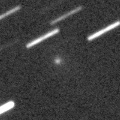
|
Now it is 17.4 mag (Nov. 5, Y. Sugiyama). First return of a new periodic comet which brightened up to 16.5 mag in 2008. The condition of this apparition is very good. It was expected to brighten up to 15.5 mag in autumn and will be observable in good condition. But actually, it is fainter than originally expected by 2 mag.
Date(TT) R.A. (2000) Decl. Delta r Elong. m1 Best Time(A, h)
Nov. 12 23 17.60 -3 48.8 1.655 2.303 118 17.5 19:50 ( 0, 51)
Nov. 19 23 18.82 -2 16.0 1.731 2.302 112 17.6 19:24 ( 0, 53)
|
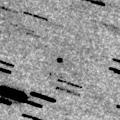
|
Now it is 17.7 mag (Nov. 3, Ken-ichi Kadota). It will pass the perihelion on Mar. 10, 2017. In the Northern Hemisphere, it keeps observable in the evening sky until late February while the comet will be brightening up to 8.5 mag. In the Southern Hemisphere, it will appear in the morning sky in late March at 8 mag, then it keeps observable while the comet will be fading.
Date(TT) R.A. (2000) Decl. Delta r Elong. m1 Best Time(A, h)
Nov. 12 23 7.00 7 23.5 1.317 2.006 120 17.5 19:39 ( 0, 62)
Nov. 19 23 0.28 6 19.9 1.335 1.929 111 17.5 19:05 ( 0, 61)
|
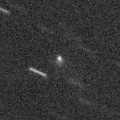
|
Now it is 17.1 mag (Nov. 5, Y. Sugiyama). It will be observable at 17.5 mag in good condition in autumn.
Date(TT) R.A. (2000) Decl. Delta r Elong. m1 Best Time(A, h)
Nov. 12 22 57.25 0 54.8 1.769 2.375 115 17.5 19:30 ( 0, 56)
Nov. 19 23 2.16 1 0.6 1.829 2.359 110 17.5 19:07 ( 0, 56)
|
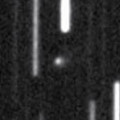
|
Now it is 17.3 mag (Nov. 9, L. Elenin). It keeps 17 mag for a long time from 2016 autumn to 2017 summer, and it keeps observable good condition all through that period in the Southern Hemisphere. In the Northern Hemisphere, it will never be observable again after this.
Date(TT) R.A. (2000) Decl. Delta r Elong. m1 Best Time(A, h)
Nov. 12 4 13.71 -55 47.6 2.235 2.672 105 17.5 0:49 ( 0, -1)
Nov. 19 3 56.71 -58 43.8 2.261 2.645 101 17.5 0:05 ( 0, -4)
|

|
It brightened up to 13-14 mag from 2014 to 2015. Now it is fading. It has already faded down to 18.0 mag (Nov. 5, K. Hills). It will be fainter than 18 mag in December.
Date(TT) R.A. (2000) Decl. Delta r Elong. m1 Best Time(A, h)
Nov. 12 22 58.29 -8 7.4 5.688 6.141 112 17.5 19:31 ( 0, 47)
Nov. 19 22 59.06 -8 7.4 5.841 6.186 105 17.6 19:04 ( 0, 47)
|

|
Now it is 17.0 mag (Nov. 10, Purple Mountain Observatory, XuYi Station). It keeps observable at 17.5 mag in good condition from autumn to winter.
Date(TT) R.A. (2000) Decl. Delta r Elong. m1 Best Time(A, h)
Nov. 12 3 25.81 16 41.2 2.086 3.074 175 17.6 0:02 ( 0, 72)
Nov. 19 3 21.20 16 14.4 2.084 3.070 174 17.6 23:25 ( 0, 71)
|
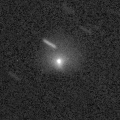
|
It has brightened in outburst up to 14 mag twice, in 2006 January and 2011 May. Third outburst occured on Aug. 28, and it brightened up to 14.8 mag (Aug. 30, Juan Jose Gonzalez). It has already faded down to 17.4 mag (Nov. 2, Katsumi Yoshimoto). It is observable in good condition for a while.
Date(TT) R.A. (2000) Decl. Delta r Elong. m1 Best Time(A, h)
Nov. 12 1 4.39 4 18.3 5.560 6.409 146 17.7 21:36 ( 0, 59)
Nov. 19 1 2.86 4 8.3 5.643 6.423 139 17.8 21:07 ( 0, 59)
|
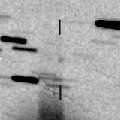
|
Now it is 17.8 mag (Nov. 5, Catalina Sky Survey). First return of a new periodic comet discovered in 2005. In the Northern Hemisphere, it will be observable in excellent condition in winter. It locates somewhat low in the Southern Hemisphere. It is fainter than originally expected by 1 mag.
Date(TT) R.A. (2000) Decl. Delta r Elong. m1 Best Time(A, h)
Nov. 12 3 48.76 23 17.6 1.843 2.822 169 18.3 0:25 ( 0, 78)
Nov. 19 3 44.14 22 56.0 1.836 2.823 176 18.3 23:48 ( 0, 78)
|
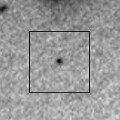
|
Now it is 18.9 mag (Oct. 27, Ken-ichi Kadota). First return of a new periodic comet discovered in 2007. It was expected to brighten up to 16.5 mag and will be observable in good condition from autumn to winter. But actually, it is fainter than originally expected by 2 mag.
Date(TT) R.A. (2000) Decl. Delta r Elong. m1 Best Time(A, h)
Nov. 12 3 24.54 -13 37.3 1.451 2.352 148 18.5 0:00 ( 0, 41)
Nov. 19 3 18.86 -13 3.4 1.442 2.334 147 18.5 23:22 ( 0, 42)
|
|
![]()
 C/2013 US10 ( Catalina )
C/2013 US10 ( Catalina ) D/1978 R1 ( Haneda-Campos )
D/1978 R1 ( Haneda-Campos ) C/2014 W2 ( PanSTARRS )
C/2014 W2 ( PanSTARRS ) C/2016 R2 ( PanSTARRS )
C/2016 R2 ( PanSTARRS ) C/2016 A8 ( LINEAR )
C/2016 A8 ( LINEAR ) 56P/Slaughter-Burnham
56P/Slaughter-Burnham 226P/Pigott-LINEAR-Kowalski
226P/Pigott-LINEAR-Kowalski C/2015 VL62 ( Lemmon-Yeung-PanSTARRS )
C/2015 VL62 ( Lemmon-Yeung-PanSTARRS ) 53P/Van Biesbroeck
53P/Van Biesbroeck 93P/Lovas 1
93P/Lovas 1 C/2016 N4 ( MASTER )
C/2016 N4 ( MASTER ) 73P/Schwassmann-Wachmann 3
73P/Schwassmann-Wachmann 3 C/2014 B1 ( Schwartz )
C/2014 B1 ( Schwartz ) 74P/Smirnova-Chernykh
74P/Smirnova-Chernykh (3200) Phaethon
(3200) Phaethon C/2015 V1 ( PanSTARRS )
C/2015 V1 ( PanSTARRS ) 188P/LINEAR-Mueller
188P/LINEAR-Mueller C/2013 V4 ( Catalina )
C/2013 V4 ( Catalina ) 118P/Shoemaker-Levy 4
118P/Shoemaker-Levy 4 C/2014 R3 ( PanSTARRS )
C/2014 R3 ( PanSTARRS ) C/2014 A4 ( SONEAR )
C/2014 A4 ( SONEAR ) C/2016 A1 ( PanSTARRS )
C/2016 A1 ( PanSTARRS ) C/2010 U3 ( Boattini )
C/2010 U3 ( Boattini ) P/2015 TP200 ( LINEAR )
P/2015 TP200 ( LINEAR ) C/2015 X7 ( ATLAS )
C/2015 X7 ( ATLAS ) 136P/Mueller 3
136P/Mueller 3 338P/2016 N1 ( McNaught )
338P/2016 N1 ( McNaught ) 2P/Encke
2P/Encke 343P/2016 P3 ( NEAT-LONEOS )
343P/2016 P3 ( NEAT-LONEOS ) P/2016 S1 ( PanSTARRS )
P/2016 S1 ( PanSTARRS ) C/2012 F3 ( PanSTARRS )
C/2012 F3 ( PanSTARRS ) 128P/Shoemaker-Holt 1
128P/Shoemaker-Holt 1 174P/(60558) 2000 EC98 ( Echeclus )
174P/(60558) 2000 EC98 ( Echeclus ) P/2016 Q1 ( Read )
P/2016 Q1 ( Read ) P/2016 R1 ( Catalina )
P/2016 R1 ( Catalina )![]()












































